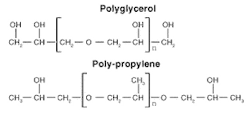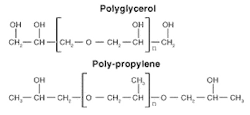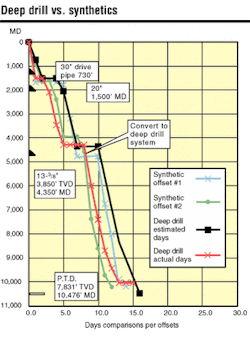How to ensure fluids meet environmental discharge compliance
By Don Chamberlain, Del Leggett
Newpark Drilling Fluids LLC
Operational necessity and a changing regulatory landscape have fueled a renewed search by Gulf of Mexico operators for viable alternatives to high-performance, synthetic-based drilling fluid systems.
Over the past several years, drilling fluid providers have introduced a number of new wrinkles to their water-based offerings. These range from enhancing existing technology to developing entirely new systems that address specific operational goals. The industry's mission is to find environmentally appropriate drilling fluids systems that satisfy performance criteria, including drilling rates, lubricity, wellbore inhibition, and production zone protection. The enviable track record notched by synthetics has effectively "raised the bar" in terms of performance criteria, thus making the search for a water-based option a daunting task.
DeepDrill, a proprietary water-based system, marks the direction chosen by Newpark Drilling Fluids LLC to achieve these lofty performance goals. The continued development of the system is an effort to overcome two primary shortcomings of synthetics: tightening standards for discharge of fluids and cuttings into federal offshore waters, and the heightened potential for prohibitively expensive bouts with lost returns and related problems associated with synthetics.
The system is designed to ensure environmental discharge compliance while providing wellbore stabilization in applications where potential drilling problems associated with synthetics diminish the viability of that choice in certain situations.
System description
The system achieves wellbore stabilization via the incorporation of methyl glucoside with chemically active polyglycerols containing hydroxyl groups that attach to the clay/shale surfaces, thus impeding water movement into the shale under downhole conditions. These complex polyols represent a step beyond traditional glycol drilling fluids chemistry.
The hydroxyl groups contained in polyglycerol and methyl glucoside are numerous as compared to polyglycols, which contain functional hydroxyls only at each end of the organic chain. Additionally, the 3D multi-tiered structure of the methyl glucoside is unique. The complex nature of this molecule is considerably more effective in sealing pores than simple polyols. Further, this molecular configuration tends to prevent damaging penetration of the material into the shale adjacent to the wellbore.
The increased availability of hydroxyls promotes development of a strong bond with shale surfaces and pore throats. This mechanism, achieved through the coupling of various polyglycerols and methyl glucoside with the formulation, provides a molecular particle size distribution that effectively coats or films the wellbore, preventing water migration into the shale, while also preventing wetting and clay-particle migration.
The synergy achieved by combining polyglycerol's lubricating ability with the wellbore-stabilizing qualities of methyl glucoside blends the two separate technological approaches into a single system exhibiting environmentally friendly wellbore stabilization, lubricity, and improved penetration rates.
Lubricating qualities of the system have resulted in minimal torque and drag in field applications. In one Ewing Bank deepwater well, the directional company calculated coefficients of friction of 0.12 for the cased-hole section and 0.19 for the open hole. These are comparable to readings attained with synthetic-based fluid.
The system also exhibits tolerance to common drilling contaminants such as salt, anhydrite, and water flows. Its inherent characteristics make it a viable choice for drilling depleted sands as well as sub-salt environments. Further, its water-based formulation provides superior electric log interpretation, and return permeability test results indicate the system to be protective of production zones.
The fluid and drill cuttings may be discharged into federal outer continental shelf (OCS) waters, as typical LC50 bioassay values (mysid shrimp) are around 500,000 ppm, well within acceptable range.
The system reflects refinement in formulation resulting from several years of research and development. Results of tests conducted by OGS Laboratory Inc. with its unique Downhole Simulation Cell, provided researchers evidence of fluid performance in drilling actual formation samples under conditions mimicking in situ stresses and temperatures. Such tests provide evidence of fluid transfer between drilling fluid and shales, as well as fluid effects upon shale strength and stability and general changes in shale composition.
Typical deepwater formulation
A typical deepwater formulation for this system contains 20% (weight) salt for hydrate suppression and activity reduction; 20% (volume) DeepDrill Inhibitor for membrane development, further hydrate and activity suppression, and lubricity; conventional additives for viscosity and filtration control; polymeric thinners for deflocculation; and a resin-based high-pressure/high-temperature (HP/HT) filtration control agent.
Field results
To date, over 80 field applications of the methyl glucoside/polyglycerol system have been accomplished by the provider, in depths ranging from 5,212 ft to 25,530 ft measured depth, and in hole angles ranging from vertical to horizontal. Mud weights ranged from 9.3 ppg to 17.7 ppg and bottom hole temperatures went up to 385° F.
Over three-dozen offshore applications, in water depths ranging from 200 to 6,770 ft, have been achieved.
Ewing Bank results
At Ewing Bank, 10 wells have employed the system for drilling the 8 1/2-in. production interval after synthetic-based mud (SBM) system efforts resulted in unacceptable downtime as a result of lost returns and formation ballooning. Results achieved provide sufficient data for performance comparisons between the two systems.
There, the methyl glucoside/polyglycerol system averaged 31.3 ft/hr penetration rate as compared to SBM's 52.5 ft/hr. Rig days on those intervals, however, were equal, averaging 10 days with each system. Mud cost/ft was 43% lower with the water-based fluid, and roughly equal to the cost/ft of a sodium chloride/partially hydrolyzed polyacrylamide (PHPA) system employed on a prior well.
More importantly, drilling problems associated with lost returns were minimized. In three of the wells, a 3,500 psi depleted sand was directionally penetrated with hole angles from 30-40 degrees. In another well, a 1,000-ft salt structure was drilled with no disruption.
Case history: Green Canyon
Weak shales encountered in a major operator's well at Green Canyon (water depth greater than 3,000 ft) threatened the success of the operation. An SBM and its inherently elevated circulating densities taxed the formation's matrix strength and resulted in formation ballooning and lost returns.
The methyl glucoside/polyglycerol system was chosen as a water-based option based on its ability to provide wellbore stability, lubricity, and high penetration rates. It was also chosen because its water-based formulation provided lower downhole density than did the SBM.
The compressibility of synthetic-base oil results in higher downhole densities than virtually non-compressible, water-based fluids. In this case, the calculated physical difference approximated .5 ppg.
The 14 ppg methyl glucoside/polyglycerol system displaced the SBM before drilling out of the 7 5/8-in. liner shoe at 15,821 ft, and density was raised in stages to 14.5 ppg to combat stubborn background gas. The operator performed a formation "jug" test, yielding a 15.59 ppg equivalent mud weight result.
The well was shut in when it flowed at 15,955 ft, but with no drillpipe pressure. The well was opened and circulated out. A lost circulation pill was squeezed into the formation after a second leak-off test yielded only a 13.1 ppg result.
A kick occurred with 14.5 ppg mud weight at 16,026 ft, and the well was shut in with shut-in casing pressure of 115 psi and shut-in drill pipe pressure of 57 psi. The well was circulated out on choke as mud density was increased from 14.5 to 14.7 ppg. No excessive torque or drag or stuck pipe was experienced. No mud losses were experienced. The well was then successfully drilled to total depth of 16,750 ft with no further problems. Penetration rates were controlled at 60 to 100 ft/hr throughout the interval.
Summary
The methyl glucoside/polyglycerol system has consistently eliminated lost circulation and/or ballooning experienced with SBM.
It has been employed to drill depleted/overbalanced sands with pressure differentials as high as 6,500 psi (3,500 psi in deviated wells). It has also successfully negotiated significant salt structures. It complies with new federal waters regulations regarding cuttings discharge, thereby streamlining permitting and reporting requirements as well as cost savings with equipment and personnel for operators' compliance assurance. Penetration rates have varied, but the system has consistently out-performed other water-based systems, while PDC bits have yielded good results in many situations. Hole stability and calipers have been excellent. The system has also been used effectively in cases where the wellbore had previously been fractured with SBM. Further refinements continue to widen the range of applications for this innovative system.



